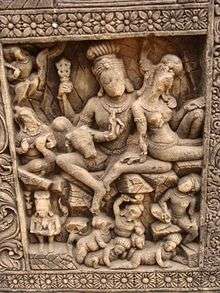Malhar, Chhattisgarh
Malhar is a small town situated in Bilaspur district of Chhattisgarh, India. It has archaeological significance. It is 40 km away from Bilaspur by road.
Oldest Vishnu
The oldest known sculpture of Vishnu with four-arm figure holding shankha, chakra and gada dated to c. 200 BCE was found in Malhar, Chhattisgarh.[1]
Legends
In ancient Indian literature as well as the epic Ramayana, Mahabharata and Puranas there are many references to the ancient Kosala Kingdom of northern India. Surya Vanshi Ikshvaku dynasty kings ruled Kosala with Ayodhya as their capital. Sri Ramachandra was a king of that clan, based on whose character and activities, the Ramayana was written. This work mentions that after Rama, the kingdom was divided among his two sons, Lava and Kusha. North Kosala went to Lava as his share with Shravasti Nagari as his capital while Kusha received South Kosala. He established his new capital, Kushasthalipura on the riverKushavrate near the Vindhya mountain range, which divides north and south India. Kushasthalipura is identified as near Malhar in the present-day Bilaspur district of Chhattisgarh state.
As part of his military campaigns, Sahadeva targeted the kingdoms in the regions south of the Indo-Gangetic Plain. Vanquishing the invincible Bhismaka, Sahadeva then defeated the king of Kosala in battle and the ruler of the territories lying on the banks of the Venwa, as well as the Kantarakas and the kings of the eastern Kosalas.[2]
Archaeological Sites
In Malhar, many ancient temples have been found, such as the Pataleshwar temple, the Devri temple & the Dindeshwari temple. Ancient deposits and Jain memorials were also found here. The four handed idol of Vishnu is significant. The remains found here are of the period from approximately 1000 BCE to the Ratnapura Kalachuri regime. Temples of the 10th and 11th centuries are also conspicuous. Among them, the Pataleshwar Kedar temple is one, where the Gomukhi Shivling is the main attraction. The Dindeshwari temple of the Kalachuri regime is also significant. Artistic idols are present in the Deor temple. There is also a museum in Malhar, being managed by the Government of India, having a good collection of old sculptures.

The excavation at Malhar found past history of many kingdoms of South Kosala:[3]
- Period 1 - Protohistoric (c 1000 BC to 350 BC)
- Period 2 - Maurya, Sunga, Satavahana (c 350 BC to 300 AD)
- Period 3 - Sharabhapuriyas and Somavasis (c 300 to 650 AD)
- Period 4 - Later Somavamsis (c 650 to 900 AD)
- Period 5 - Kalachuris (c 900 to 1300 AD)
Malhar is in the list of "Ancient Monuments and Archaeological Sites and Remains of National Importance" maintained by the Archaeological Survey of India.
References
- Nanditha Krishna (2009). The Book of Vishnu. Penguin Books India. pp. 25–6. ISBN 978-0-14-306762-7.
- Mahabharata, Book 2, Chapter 30
- Om Prakash Misra (2003). Archaeological Excavations in Central India: Madhya Pradesh and Chhattisgarh. Mittal Publications. pp. 134–135.
External links
- Welcome to Bilaspur
- Map of Bilaspur, Chhattisgarh
- Tourist places of Bilaspur District
- Bilaspur becoming smart city
- Malhar Bilaspu